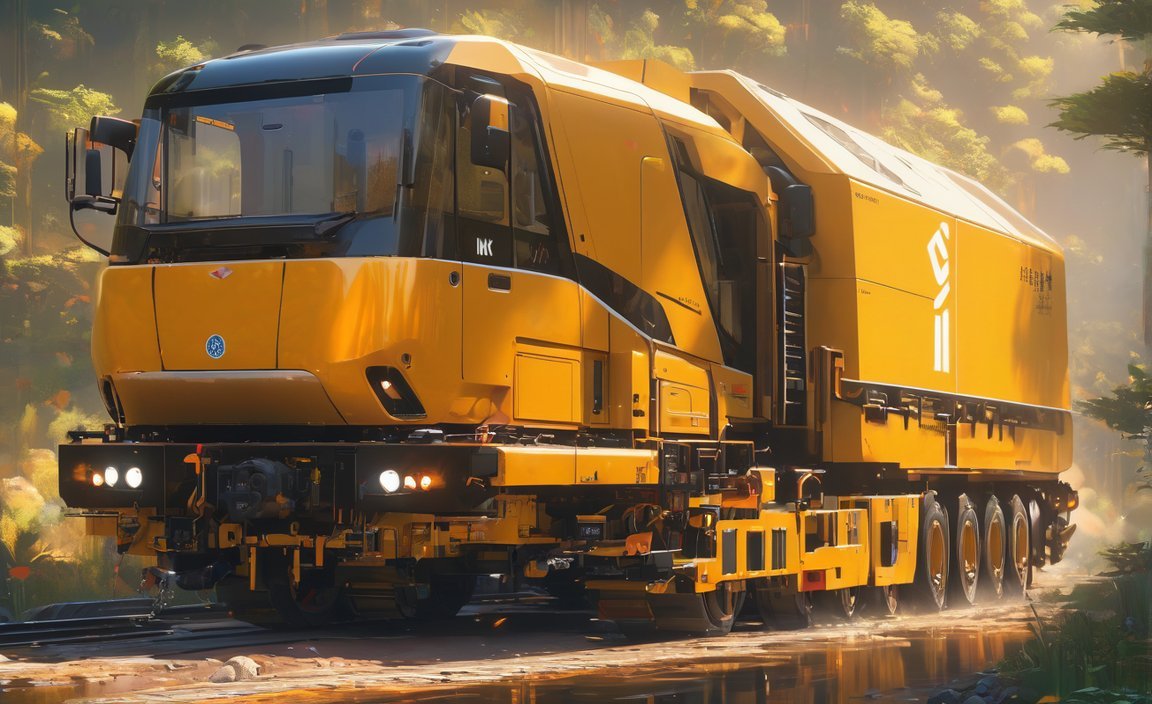Land transportation acts as the very foundation of our interconnected world, seamlessly moving people and products with efficiency and speed. From bustling city streets to sprawling highways connecting nations, land transportation forms the backbone of modern society. Let’s explore why this method remains so crucial in our world.

Advantages of Land Transportation
When it comes to moving goods and people, land transportation often emerges as the go-to solution for its practicality and numerous advantages. Its significance in connecting communities and driving economies is undeniable, but the benefits extend far beyond mere convenience.
One of the most compelling aspects of land transportation lies in its remarkable versatility. Like a trusty Swiss Army knife, it adapts to a wide range of needs. Whether transporting massive loads of construction materials or delicate, high-value artwork, land transportation rises to the occasion. What’s more, it can reach even the most remote locations, unlike some other modes of transport. This unparalleled accessibility ensures that everyone, from bustling metropolises to quiet countryside towns, can access essential goods and services.
And then there’s the matter of cost. Shipping goods overseas or via air can quickly become expensive. This is where land transportation presents a compelling advantage. It generally offers a more budget-friendly approach, especially when factoring in fuel costs and logistical complexities. Shorter routes and reduced handling also translate to a lower risk of damage or loss during transit. This inherent efficiency benefits not only businesses but also the environment. Land transportation generally boasts a smaller carbon footprint compared to air or sea freight, a factor that has prompted many governments and companies to invest heavily in enhancing road and railway infrastructure, positioning it as a sustainable choice for the future.
Consider the last time you ordered something online. Chances are, a truck brought that package right to your doorstep. Land transportation provides this level of door-to-door convenience that other methods struggle to match. This seamless connection between businesses and customers is revolutionizing commerce, streamlining the entire process, and increasing speed and efficiency.
Of course, no system is without its limitations. While land transportation excels in many areas, it does face challenges when it comes to speed, particularly over very long distances. However, innovators are actively working to address this. With exciting developments like high-speed rail lines and sophisticated, super-efficient routing systems constantly emerging, the gap is closing.
Here’s a concise table highlighting the key advantages of land transportation:
| Advantage | Benefit |
|---|---|
| Versatility | Can transport a diverse array of goods to various locations |
| Cost-effectiveness | Typically more affordable than other transportation methods |
| Environmental Friendliness | Often has a lower environmental impact |
| Flexibility | Offers customizable routes and the convenience of direct delivery |
As the world continues to evolve, land transportation will undoubtedly remain a vital force in connecting communities and propelling economies forward. It’s a sector ripe for innovation, and the potential advancements in the near future are incredibly exciting.
Advantages of inland waterways can revolutionize transportation with their efficiency and sustainability. Learn more about the benefits of inland waterways here.
Discover the numerous advantages of an intelligent transport system that enhances efficiency and reduces congestion here.
Unveil the advantages of maritime transport, such as cost-effectiveness and accessibility to remote areas, by clicking here.
Unlock the benefits of ocean transport, including its capacity for large-scale shipping and global connectivity, by clicking here.

What are the advantages of transportation?
Expanding on the significance of land transportation, let’s delve into its impact on our daily lives. Acting as the circulatory system of the modern world, it ensures the steady flow of people, goods, and services, enabling societies to function and thrive.
Without reliable transportation, particularly in rural communities, access to essential services concentrated in larger towns and cities becomes a significant challenge. A well-connected network of roads and railways bridges this gap, fostering inclusivity and ensuring that geographic location doesn’t hinder access to opportunities and a good quality of life. This interconnectedness is paramount for inclusive growth, ensuring that no one is left behind.
When it comes to shipping goods, particularly across shorter distances, the cost-effectiveness of land transportation is tough to beat. Trucks and trains are the unsung heroes of commerce, efficiently moving products without the hefty price tag often associated with air or sea freight. These cost savings can then be passed down to consumers, making goods more affordable.
But the benefits extend beyond pure economics. In an era deeply concerned about climate change, land transportation, especially rail networks, stands out as a more environmentally responsible option. Rail, in particular, generates considerably fewer emissions per ton of cargo compared to other modes of transport. Choosing land-based solutions can be a significant step towards cleaner air and a healthier planet.
Investing in land transportation infrastructure is akin to investing in a brighter future. The construction and maintenance of roads, railways, and transportation hubs create numerous job opportunities. This, in turn, attracts businesses and investments, setting off a ripple effect of economic growth that benefits entire regions.
Let’s recap the key advantages:
| Advantage | Description |
|---|---|
| Accessibility & Connectivity | Bridges the gap between urban centers and remote areas, ensuring everyone has access to opportunities and essential services. |
| Cost-Efficiency | Provides budget-friendly solutions for moving goods, especially over shorter distances, benefiting both businesses and consumers. |
| Environmental Sustainability | Offers a greener alternative, particularly rail networks, which generate fewer emissions compared to other modes, contributing to a cleaner and healthier planet. |
| Economic Growth | Acts as an engine for job creation and economic development by stimulating construction, attracting investments, and facilitating the smooth flow of goods and services. |
The field of transportation is in a constant state of evolution. New technologies and approaches are continuously emerging, with ongoing research focused on making transportation even more efficient, sustainable, and accessible. This makes it a thrilling area to track, as the future of transportation is brimming with possibilities.
What is the main advantage of road transport?
Having already established the many benefits of road transport, let’s focus on what makes it so exceptional. One of its most remarkable features is its remarkable flexibility – a true go-anywhere, haul-anything solution. Unlike other modes of transportation that may necessitate specific routes or have inherent limitations, trucks can reach practically any destination accessible by road. This makes it immensely convenient for both businesses and individuals, as they are not restricted by fixed schedules or locations. Need a delivery to a remote farm or a bustling city center? Road transport is up to the task.
Speaking of convenience, cost-effectiveness is another major advantage. Road transport tends to be gentler on the budget compared to air or rail, particularly for shorter distances. Building and maintaining roads is generally more affordable than the infrastructure required for air or rail, making it a more accessible option for smaller businesses or individuals operating with tighter budgets. Additionally, operational costs are usually lower, a welcome benefit for any business.
While road transport may not always be the fastest option – air travel undeniably takes the crown in that regard – it is by no means slow. When factoring in its directness, it can often be the quickest way to transport goods from point A to point B. There’s no waiting around at airports or train stations; shipments are loaded and on their way, making deliveries faster and smoother.
Importantly, road transport has evolved to safely and reliably handle fragile or valuable cargo. Advancements in security and tracking technology provide businesses and individuals with peace of mind, knowing they can closely monitor their precious shipments.
As with any system, road transport does have potential drawbacks, such as traffic congestion and unpredictable weather conditions. However, researchers and engineers are continuously developing ways to enhance its efficiency, safety, and reliability. So, the next time you see a truck on the highway, remember that it’s more than just a vehicle; it’s a vital cog in the global network that connects us all.
What are the Advantages and Disadvantages of Trading over Land?
Let’s take a closer look at the specific advantages and disadvantages of moving goods across land. Like any aspect of commerce, there are pros and cons to consider:
Advantages:
- Cost-Effectiveness: For shorter distances, trucking offers a budget-friendly option that benefits both businesses and consumers.
- Wide Reach: Land routes can reach areas that may lack access to airports or harbors, opening up opportunities for businesses in less developed regions.
- Flexibility: Trucks and other land-based vehicles offer a level of flexibility unmatched by other methods. Adjusting delivery schedules or navigating around road closures is generally more achievable.
- Safety: Land transport is typically very safe, with a relatively low risk of goods being damaged or lost during transit.
Disadvantages:
- Speed Limitations: Trucks can’t compete with the speed of airplanes, making land transport less suitable for time-sensitive deliveries over long distances.
- Capacity Constraints: The amount of cargo that can be carried by a truck or train is limited, which can pose challenges when transporting large quantities of goods, particularly raw materials or heavy equipment.
- Traffic Congestion: Traffic jams can cause significant delays, leading to increased costs and disruptions to supply chains.
- Environmental Impact: Diesel trucks, while essential, contribute to air pollution. This is an ongoing concern that the industry is actively addressing through the development of electric trucks and more sustainable practices.
In Conclusion:
Land transportation is the workhorse of global trade. It’s affordable, widely accessible, and offers a good deal of flexibility. However, speed limitations, capacity issues, and the impact on the environment are all areas where improvements can be made. Fortunately, researchers and companies are constantly exploring new technologies and strategies to make land-based trade faster, greener, and more efficient.
What are the advantages and disadvantages of water transportation?
Water transportation has long been a cornerstone of global trade and development. Let’s delve into the specific pros and cons of this mode of transport:
Advantages:
- Cost-Effectiveness: Water transportation is exceptionally cost-effective for moving large quantities of goods, especially bulk cargo. This is because waterways require less expensive infrastructure and maintenance compared to roads or airports.
- Environmental Friendliness: In an era increasingly focused on environmental impact, water transportation often stands out as a greener choice. Ships generally have a smaller carbon footprint compared to trucks, trains, and airplanes, particularly when considering the sheer volume of cargo they can transport in a single trip.
- Reliability: Waterways offer a level of predictability unmatched by other methods. They are less susceptible to disruptions from weather events or traffic congestion. This reliability makes it more likely that goods will arrive on schedule, a critical factor for businesses and consumers.
- Accessibility to Remote Areas: Water transportation acts as a lifeline for remote areas and regions that are difficult or impossible to reach by land or air. This ensures that island communities, coastal regions, and areas with challenging terrain are not isolated and can participate in trade and receive essential goods.
Disadvantages:
- Speed Limitations: Water transportation is not the fastest option. Ships travel at slower speeds compared to other methods, and weather delays or port congestion can add further delays.
- Infrastructure Requirements: Water transportation relies heavily on well-maintained ports, canals, and navigable waterways. Establishing and maintaining this infrastructure requires significant investment and time, which can be a barrier in developing countries or regions lacking suitable waterways.
- Security Concerns: The vastness of the ocean presents unique security challenges. Piracy, theft, and even terrorism are risks that shipping companies must address through stringent security measures to protect both vessels and cargo.
- Environmental Impact: While generally considered environmentally friendly, water transportation does have an environmental footprint. Emissions from ships contribute to air pollution, and there’s always the risk of accidents resulting in oil spills or other damage to marine ecosystems. Ongoing research and innovation in ship design and technology are crucial to mitigate these risks and enhance the sustainability of water transport.
In Conclusion:
Water transportation presents a unique set of benefits and drawbacks. It’s a crucial component of the global trade network, especially when considering its cost-effectiveness and relatively low environmental impact. However, speed limitations and the need for substantial infrastructure investments are key challenges that need addressing. Ongoing research and the development of sustainable technologies are essential to maximize the benefits of water transportation while minimizing its environmental impact.
What are the 5 advantages of rail transport?
Rail transport has long been a cornerstone of transportation systems worldwide. Let’s break down five key advantages that make it such a vital mode of transport:
1. Cost-Effectiveness:
When it comes to moving large quantities of goods over long distances, trains are the undisputed champions of cost-effectiveness. They can be 10-40% cheaper than trucking due to their fuel efficiency and ability to transport massive volumes in a single trip.
2. Environmental Sustainability:
In an era increasingly focused on climate change, trains offer a greener alternative to more emissions-heavy modes of transport like trucking. Their fuel efficiency translates to significantly lower greenhouse gas emissions per ton of cargo, making them a more environmentally responsible choice.
3. High Capacity:
Trains excel at moving massive amounts of cargo. A single freight train can haul the equivalent of hundreds of truckloads, making them indispensable for transporting bulk goods such as coal, ore, and agricultural products.
4. Reliability:
Trains operate on fixed schedules and dedicated tracks, making them incredibly reliable. They are less susceptible to delays caused by weather, traffic congestion, or accidents, ensuring that goods arrive on time and minimizing disruptions to supply chains.
5. Guaranteed Capacity:
The consistency of rail transport offers businesses a level of predictability that’s invaluable. Unlike trucking, where the availability of trucks can fluctuate, trains provide a guaranteed amount of space for cargo. This eliminates the need for businesses to scramble for transportation during peak seasons and mitigates the risk of goods being delayed due to capacity constraints.
The Takeaway:
While new and innovative transportation technologies continue to emerge, trains remain a powerhouse of efficiency, affordability, and sustainability. Their distinct blend of advantages solidifies their place as a vital part of a balanced and robust transportation system.
What is the Main Advantage of Modern Transport?
Modern transportation, particularly land-based systems, has fundamentally reshaped our world. One of its most significant advantages is the freedom it affords us, particularly in terms of moving goods across vast distances.
Trucks, trains, and even the delivery vans that have become ubiquitous in our cities provide unparalleled flexibility. They can reach nearly every corner of the globe, from bustling city centers to remote villages. This adaptability has transformed the global economy, allowing businesses to reach wider markets and consumers to access a wider array of goods.
For shorter trips, land-based transport often emerges as the most cost-effective option. This affordability benefits businesses and, ultimately, consumers through lower prices.
Modern highways and high-speed rail lines act as supercharged shortcuts, significantly reducing travel times for people and goods. This speed is crucial for businesses operating in time-sensitive industries and is a key factor in the rapid growth of e-commerce and the expectation of speedy deliveries.
It is crucial to acknowledge the environmental impact of modern transportation, particularly the emissions produced by vehicles. However, there is a strong push for greener solutions. Electric vehicles and more fuel-efficient engines are becoming increasingly common, representing significant progress in minimizing the carbon footprint of the transportation sector.
Some experts believe that through continued investments in sustainable technologies, land transportation can become even more environmentally friendly in the future. With ongoing research into alternative fuels and intelligent traffic management systems, the potential for innovation in this field is vast.
While challenges remain to be addressed, modern land transportation is undeniably a driving force in our world, connecting communities, fueling economies, and, hopefully, becoming more sustainable with each passing day.
What is the importance of transportation?
Transportation is so deeply ingrained in our lives that it’s easy to overlook its fundamental importance. Imagine a world without cars, trains, planes, or ships – it would be a world in disarray. We rely on transportation systems for almost every aspect of our daily lives.
At its core, transportation connects us. The food we consume, the clothes we wear, the electronics we use – all of these have likely traveled countless miles via trucks, trains, ships, or planes to reach us. This continuous movement of goods is the lifeblood of our global economy. It allows businesses to reach customers worldwide and provides consumers access to a vast and diverse range of products.
However, it transcends the mere movement of goods. Transportation connects people, enabling us to visit loved ones in distant cities, explore new and exciting destinations, and commute to work or school. It provides us with freedom and opportunity. Imagine trying to pursue a job opportunity located hours away without reliable transportation – a daunting prospect, to say the least.
Of course, different modes of transportation have their strengths and weaknesses. Let’s take a closer look at some key areas:
Accessibility:
- Land transportation, encompassing cars, buses, and trains, excels in reaching a wide array of locations. It can navigate through bustling cities, rugged mountains, and arid deserts, ensuring that even the most remote communities can access essential goods and services.
Cost-Effectiveness:
- For shorter journeys, road transport, primarily trucks, reigns supreme. It’s typically the most affordable option for transporting goods locally and regionally. The faster delivery times associated with road transport also translate to businesses being able to restock shelves quickly and efficiently, keeping consumers happy.
Efficiency:
- While air transportation might be the fastest way to move goods over long distances, nothing surpasses ships when it comes to sheer volume and cost-effectiveness. These behemoths of the sea carry an astounding amount of cargo across the globe, making international trade on a massive scale possible.
Investment:
- While establishing roads and railways requires upfront investment, it’s comparatively more economical than building airports. This makes land transportation a more viable option for developing countries, playing a crucial role in boosting their economies and strengthening the links between cities and towns.
Sustainability:
- It’s crucial to acknowledge the environmental impact of transportation systems, particularly those reliant on fossil fuels. The good news is that there is a strong global push towards developing and implementing sustainable transportation solutions. This includes electric vehicles, biofuels, and high-speed rail networks that can transport people quickly and efficiently without relying solely on gasoline.
The Future of Transportation:
The field of transportation is alive with innovation. Scientists and engineers are constantly striving to make transportation faster, safer, and more environmentally friendly. Self-driving cars, hyperloop technology, and even flying taxis – concepts that once seemed like science fiction are inching closer to reality. It’s an exciting time to witness how these advancements will shape the future of mobility.
What are the advantages of transport and communication?
Transportation and communication are the twin pillars of the modern world. They are not merely about moving from one location to another or sending messages; they are the very bedrock upon which global societies are built and interconnected. Let’s delve into the specific advantages they offer and how they influence our daily lives:
Land transportation, through roads, railways, and canals, plays a crucial role in the movement of people and goods, from local commutes to intricate global supply chains. It’s the engine that keeps businesses running, facilitates international trade, and ensures that we have access to the things we need.
Communication technologies, like mobile phones, the internet, and social media, have become so ingrained in our lives that it’s easy to take them for granted. These technologies have revolutionized the way we interact, providing instant access to information from every corner of the globe and allowing us to stay connected to loved ones regardless of distance.
Here are some of the profound advantages that transport and communication systems offer:
- Economic Growth: They are powerful engines of economic growth. Efficient transportation networks allow for the faster and more cost-effective movement of goods, which in turn drives trade and stimulates economic activity. Communication technologies facilitate global collaboration, accelerate innovation, and foster the sharing of knowledge, further contributing to economic prosperity.
- Improved Access to Education and Healthcare: Imagine how access to education and healthcare in a remote village can be transformed through improved transportation and communication infrastructure. Children can get to school more easily, and medical professionals can reach patients in need more quickly.
- Strengthened Social Connections: Humans are inherently social beings. Transportation makes it easier for us to connect with friends and family, attend social gatherings, and explore new places, enriching our lives and strengthening community bonds. Communication technologies keep us connected to loved ones who may be miles apart, providing a sense of closeness and support.
- Enhanced Safety and Security: Reliable transportation systems enable emergency services to respond swiftly to accidents or disasters. Communication technology, from mobile phones to emergency alert systems, allows us to call for help or receive critical warnings, potentially saving lives.
- Reduced Environmental Impact: While it’s true that some forms of transportation contribute to environmental problems, technological advancements are paving the way for more sustainable solutions. Electric vehicles, high-speed rail lines, and even ride-sharing initiatives are examples of how the transportation sector is evolving to minimize its environmental footprint. In communication, video conferencing and other online collaboration tools help reduce the need for business travel, resulting in lower carbon emissions.
It’s important to note that our understanding of the advantages and challenges associated with transport and communication is an ongoing process. Researchers are continuously studying how these systems impact our economies, societies, and environment. As technology advances at an ever-increasing pace, we can anticipate further innovation that will bring about transformative changes in the way we live, work, and experience the world.
However, we must also acknowledge the challenges that come with these advancements. Rising urbanization and increasing dependence on transportation can strain infrastructure, leading to traffic congestion and pollution. Similarly, the rapid spread of information online requires constant vigilance in combating misinformation and promoting digital literacy.
One thing remains clear: transport and communication are not merely conveniences but essential aspects of our lives, shaping our world in profound and ever-evolving ways. As technology continues to advance, so too will the impact of these essential systems, leading us towards a future where connectivity and accessibility are paramount.
What are the advantages and disadvantages of using public transportation?
Public transportation stands as a vital component of urban mobility, offering greener and often more economical alternatives to individual car use. However, like any system, it comes with its own set of pros and cons that are worth weighing:
Advantages:
- Cost Savings: Owning and operating a private vehicle can be quite expensive. Public transportation, on the other hand, is typically far more affordable, leaving more money in your pocket for other things.
- Environmental Friendliness: Public transportation helps reduce greenhouse gas emissions by getting more cars off the road, promoting cleaner air, and contributing to healthier urban environments.
- Stress-Free Commuting: Finding parking in a busy city can be a nightmare. Public transportation eliminates this stress, allowing you to arrive at your destination without the hassle of circling for a parking spot.
- Potential for Time Savings: Getting stuck in rush hour traffic is never fun. In some cases, public transportation, especially buses using dedicated bus lanes or trains operating on separate tracks, can be faster than driving.
Disadvantages:
- Schedule Constraints: One of the downsides of public transportation is that you are bound by its schedule. This can be inconvenient if you need to be somewhere at a specific time or if your journey involves multiple transfers.
- Crowds: Let’s face it, being crammed onto a packed bus or train during rush hour isn’t the most pleasant experience. Overcrowding can be uncomfortable and can sometimes lead to delays.
- Safety Concerns: While most public transportation systems are generally safe, it’s important to be aware of your surroundings, especially at night or in unfamiliar areas. Like in any public space, it’s always wise to stay alert and take precautions.
- Limited Accessibility: This is a significant drawback. Public transportation is not readily available in all areas, and even where it is available, accessibility can be a challenge for people with disabilities or those living in more remote locations.
In Conclusion:
Deciding whether to rely on public transportation or use a private vehicle is a personal choice that hinges on individual needs and circumstances. By outlining the advantages and disadvantages, we aim to provide information that can help you make the most informed choice for your lifestyle and the well-being of our planet.
What Are the Advantages of Transport in Economics?
Transportation plays a crucial role in economics. It’s the lifeblood that connects businesses and people, creating a web of opportunities essential for growth and development.
One of the most significant benefits is the ease with which goods and services can be moved from point A to point B. This allows businesses to reach wider markets and enables individuals to access what they need, whether it be for work, leisure, or essential services. This mobility is crucial for a thriving economy.
Efficient transportation systems enable businesses to expand their reach, tap into larger markets, and achieve significant growth. This growth translates to job creation, increased investment, and a boost for the overall economy.
Consider the impact of transportation on productivity. Imagine a scenario where transportation is unreliable or inefficient. Businesses would face constant challenges in getting their products to market and consumers to their destinations. This leads to delays, frustrations, and ultimately, economic losses. A robust and efficient transportation system can prevent such scenarios, ensuring the smooth operation of supply chains, reducing transportation costs, and boosting overall productivity.
However, the advantages of transportation in economics reach far beyond profits and economic output. It plays a vital role in social good by connecting people to essential services such as healthcare and education. This accessibility helps bridge the gap between urban and rural communities, fostering a more equitable society where everyone has the chance to succeed.
Here’s a table summarizing the key advantages:
| Advantage | Explanation |
|---|---|
| Enhanced Accessibility | Easier for people to get around and for businesses to reach customers and suppliers. |
| Economic Growth | Creates jobs, attracts investment, and boosts overall economic activity. |
| Improved Productivity | Makes businesses more efficient by streamlining supply chains and reducing transportation costs. |
| Increased Market Reach | Allows businesses to access larger markets and expand their customer base. |
| Social Benefits | Improves access to healthcare, education, and other essential services. |
It’s important to remember that economics is a constantly evolving field. While we have a good understanding of the positive impact of transportation, ongoing research continues to shed light on the complexities of this relationship. Some experts believe that investing in sustainable transportation options is crucial for long-term economic growth, while others are focused on how technology will continue to reshape the transportation landscape. It’s a dynamic field full of potential for exploration and discovery.
Remember that when it comes to traveling, exploring the advantages of land transportation is always a good starting point.
- Crypto Quotes’ Red Flags: Avoid Costly Mistakes - June 30, 2025
- Unlock Inspirational Crypto Quotes: Future Predictions - June 30, 2025
- Famous Bitcoin Quotes: A Deep Dive into Crypto’s History - June 30, 2025
















